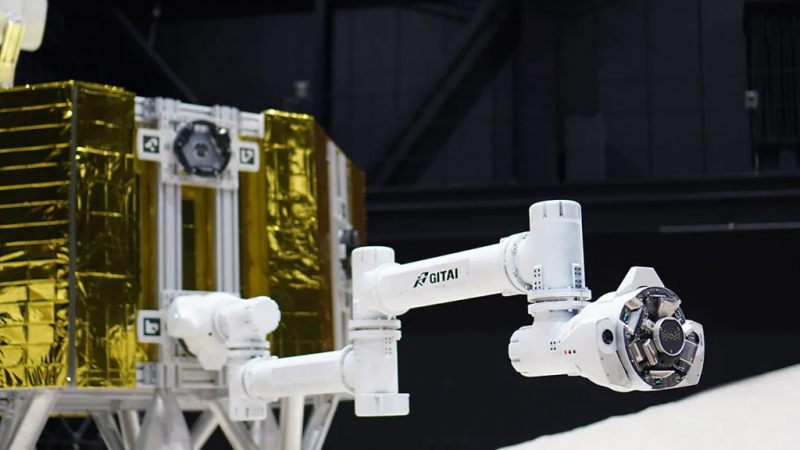
Japan's Gitai wants to create robots that will work on the Moon and Mars instead of humans
There is a groundswell of commercial space initiatives focused on the moon, with established companies and newer upstarts all seeking to transform that cold, grey rock into a thriving hub for scientific and industrial activity. But that future will likely be impossible without a suite of robotic helpers.
Tokyo-based startup Gitai thinks autonomous robots, instead of human labor, can and should be used to make this vision a reality. The company believes robots could be utilized for various activities in space, ranging from assembly to inspection and routine maintenance. To support this goal, Gitai has developed a robotic arm and a robotic rover specifically designed for in-space applications, Techcrunch.com reports.
Today, Gitai announced the closure of a $30 million (4 billion yen) Series B extension round, attracting continued interest from Japanese funds and venture firms. Notable investors include Global Brain CVC Funds, DCI Venture Growth Fund, the Dai-ichi Life Insurance Company, Ltd, ANRI III Investment Limited Partnership, ANRI I-II-III Annex Investment Limited Partnership, NVC No. 1 Limited Liability Partnership, JIC Venture Growth Fund 2 Investment Limited Partnership, Electric Power Development Company, and Mitsubishi UFJ Capital IX Limited Partnership.
The newly acquired funds will be directed towards expanding Gitai's U.S.-based workforce, as well as enhancing its manufacturing and testing capacity in the United States. Gitai CEO Sho Nakanose emphasized the startup's commitment to investing in the U.S., revealing that more than half of the Japanese workforce, including engineers, have already relocated there. Gitai has halted hiring in Japan and plans to increase its U.S. headcount by 20 by the end of this year, with a further expansion of 40-50 employees expected by the end of next year.

The company is currently in the process of constructing testing facilities for its robotics, including a mock lunar environment and a vacuum chamber. The ultimate objective is to elevate the technological readiness level of its two core robot products. The robotic arm has already undergone space testing during a technology demonstration on the International Space Station (ISS) in 2021. Gitai is now preparing for a second tech demo of the robotic arm, scheduled to take place outside the ISS next year, which presents a considerably more challenging endeavor. Additionally, the company aims to send its rover to the moon as early as 2026.
These milestones mark significant progress for the seven-year-old startup, especially considering that entering the space market was not its initial aim. Nakanose explained that when he founded the company, the space industry was the last market on his list, and he sought more practical opportunities. However, he soon recognized that Earth-based robots faced a significant market challenge: the dominance of human labor due to cost implications.
Conversely, the space industry presents unique opportunities for developers of robotics. Currently, the robotic arms attached to the ISS are expensive, with the development program for a third-gen "Canadarm" robotic arm affixed to the outside of the ISS valued at $1.2 billion. Astronaut labor is also costly and dangerous, making it impractical for extravehicular activities outside the station.
Private companies, such as Vast, Blue Origin, Voyager Space, and Axiom Space, that are developing private space stations will likely seek more cost-effective alternatives to the legacy robotics on the ISS. Gitai aims to meet this emerging market demand with its robotic arm.
- Related News
- Wheel of Death: new method will help astronauts stay fit in low gravity
- Due to anomalies of Orion spacecraft, lunar exploration program may be delayed for years։ NASA
- TAO Observatory: World's highest telescope to study evolution of galaxies and exoplanets
- Powerful M9.5 solar flare causes radio blackout in Pacific Ocean
- What will happen to the Earth if the Moon disappears?
- Key to conquering the Red Planet: Why is NASA studying solar storms on Mars?
- Most read
month
week
day
- Digital Julfa Network is launching a pan-Armenian centre in the metaverse, on the Fastexverse virtual platform 1004
- Xiaomi unveils exclusive Redmi Note 13 Pro+ dedicated to Messi and Argentina national team 886
- Sparkles: Boston Dynamics unveils a furry robot dog that can dance (video) 838
- Internet 500 times faster than 5G tested in Japan: It allows to transfer five movies in HD resolution in one second 710
- Is there a ninth planet in the solar system? Scientists find new evidence 708
- What will happen to the Earth if the Moon disappears? 697
- Smartphone catches fire in child's hand in Russia 677
- iPhone 16 may get colored matte glass back panel, 7 colors 672
- How to understand how protected a smartphone is from water and dust? 670
- World's largest 3D printer was created in USL It prints 29 meter-long structures 658
- Archive
